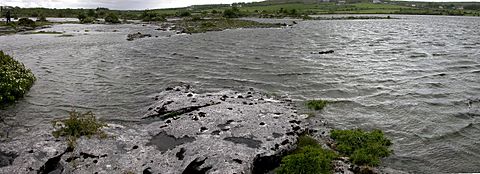Turlough (lake) facts for kids
A turlough (pronounced TUR-lock) is a special kind of lake that appears and disappears. You can find most turloughs in limestone areas of Ireland, especially west of the River Shannon. The name comes from the Irish word tur, which means "dry," and -lach, meaning "a place." So, it's like a "dry place" that sometimes fills with water! These unique lakes are found in areas where limestone rock is exposed, which scientists call karst.
Turloughs are very rare. Almost all of them are in Ireland, but there's one example in Great Britain called Pant-y-Llyn in Wales. Many scientists are interested in turloughs. For example, geomorphologists study how these lakes were formed. Hydrologists try to understand why they flood and then dry up. Botanists look at the unusual plants that grow on the turlough floor when it's dry. And zoologists study the animals that live in and around these changing waters.

Where to Find Turloughs
Most turloughs are located in the central lowlands of Ireland, west of the River Shannon. You can find them in counties like Galway, Clare, Mayo, and Roscommon. A few others are in places like Limerick, Sligo, Longford, and Cork.
Only three turloughs have been found in Northern Ireland. These are Roosky, Green, and Fardrum Loughs, near Ely Lodge Forest in County Fermanagh. They are the most northern turloughs in Ireland. These three lakes are important and are protected as a Ramsar site and an Area of Special Scientific Interest. As mentioned, there is also one turlough in South Wales, called Pant y Llyn.
Rahasane Turlough
Rahasane turlough in County Galway is the biggest turlough still existing in Ireland. It's a very important spot for birds that travel long distances or spend the winter there. In winter, you can see many different birds at Rahasane. These include greater white-fronted geese, whooper swans, wigeon, teal, and many kinds of wading birds.
See also
 In Spanish: Turlough para niños
In Spanish: Turlough para niños


